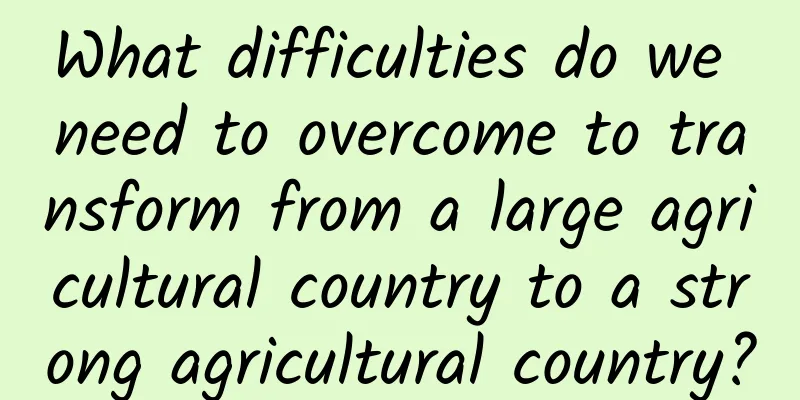What difficulties do we need to overcome to transform from a large agricultural country to a strong agricultural country?

|
As a major agricultural country, agriculture is not only the foundation of our country, but also the path to becoming a strong country. Some time ago, I saw everyone discussing "What difficulties do we need to overcome on the road to transitioning from a major agricultural country to a strong agricultural country?" In fact, agriculture, rural areas and farmers are the three components of the "Three Rural Issues". If we talk about them comprehensively, it is too difficult and my level is too low, so I will only talk about the agricultural issue, because this issue is relatively speaking the easiest to solve. Today I will talk to you about my country's agricultural issues from four aspects. 01. Scaling is the basic idea First of all, the core idea of solving the problem of my country's agriculture is: scale. Agriculture is not profitable, I believe this is the basic understanding of many people, whether it is the "low grain prices hurt farmers" issue discussed some time ago, or the previous "silage" of wheat that is about to head, both reflect this problem. But there is no way around it. The price of imported food is cheaper than domestic production. In this era of globalization, apart from the country, which company is willing to do business at a loss? Are our farmers hard-working? They are very hard-working, facing the loess and back to the sky. Even 996 working hours may not be comparable to the hard work of farmers. However, agriculture is not a matter of more input and more output, because crops have basic growth laws. Why is agriculture not profitable? The root cause is that our production costs are too high. A simple agricultural production involves many processes. From my rural experience, there are at least so many processes: plowing, base fertilizer, sowing, weeding, harvesting, straw treatment, and continuous irrigation and pesticides. In China, small-scale peasant economy is the basic form, which means that such production requires a lot of manpower and material resources, and involves more complex resource allocation issues. For example, when it comes to irrigation, there are limited wells, so who gets to irrigate first and who gets to irrigate later is a problem. When I was a child, I even heard about fights over water. In the end, our agricultural costs will be much higher. So, in contrast, what about the United States, a powerful agricultural country? Large-scale planting and large-scale mechanization. A family may manage hundreds or thousands of acres of land. They can use large-scale weed control and insecticides, including drones, but this is not possible in China. Different fields are planted with different things, and weeding cannot be done at the same time (I have experienced people using the wrong herbicide and getting nothing in return). This is especially true for irrigation. Different crops have different requirements for irrigation, so how can they be irrigated together? Therefore, centralized and large-scale agricultural production must be the inevitable direction of the future. Of course, the country has already started the land transfer process known as the "third land reform" to solve this problem. Large-scale production will greatly reduce costs. 02. Variety is the basis When it comes to agricultural issues, variety is the foundation. Oranges grown in the south of the Huai River are oranges, while oranges grown in the north of the Huai River are tangerines. How to cultivate varieties suitable for our country is also crucial. Breeding is also a historical development process. The stage of relying on the weather for food: The earliest breeding, which is also the breeding process that humans have been conducting for the past few thousand years, is breeding based on experience. Our wheat, rice, and almost all the food we see today are produced in this way. Interestingly, this breeding also determines our human diet. Borrowing the day for meals stage: By the end of the 19th century, the genetics pioneered by Mendel, coupled with subsequent research, brought breeding into the scientific field for the first time. That is, genetics is actually behind seeds, and genetic breeding began to take the stage. For example, the hybrid rice developed by Yuan Longping in my country, and the seeds that are widely used today, such as corn hybrids, are all such achievements. We can understand the above two types of breeding as: relying on nature for food. Because the seed background they rely on is essentially a naturally occurring genetic resource. Since life sciences have made progress, our understanding of genetics has also deepened, so we can naturally look for better breeding, and then the world will change. Mutation breeding Mutation breeding is a common breeding method at present. As the name suggests, it is to induce gene mutation through various methods, such as space radiation, chemical mutagenesis and other methods. Through these methods, a series of seeds that have never appeared in human history can be induced, including the familiar genetic modification, which is also a process of this kind. The difference between this and the above is that relying on nature for food is essentially being nature's porter, while induced breeding directly makes artificial changes to what exists in nature. Future breeding Although the above types of breeding are already mainstream breeding methods, from a biological point of view, these breeding methods themselves are still in a very vague stage. For example, although mutation breeding is already advanced enough, it is still a blind screening, and modern technology emphasizes precision. Therefore, we also hope to achieve breeding more accurately. This is the current research frontier. And achieving this process depends mainly on two major points. The first point is to have a deep understanding of seed genetics, that is, we need to have a very accurate understanding of the seed genome and clarify the decisive factors behind it. This is also the current mainstream scientific approach, which is to figure out which genes determine which traits. Of course, this process is very time-consuming and labor-intensive, but it is the basis. The second point is to perform precise manipulation of genes. This is also currently being done, whether it is genetic modification or gene editing, which is a more precise manipulation. Only by achieving these two points can the seeds of the future become reality. 03. Adapting to local conditions is the key Of course, these agricultural problems cannot be exactly the same across the country, otherwise it would be troublesome. For example, can Yunnan do the same planting as Henan? Yunnan's mountainous areas account for 94% of its total area. With this kind of terrain, centralization and mechanization are impossible. Therefore, it is very important to adapt to local conditions. my country's main grain producing areas are the Northeast and East China regions. Such areas have flat terrain and are very suitable for food production. However, other mountainous areas, such as Yunnan and Guizhou, may need to develop specialty agriculture, such as animal husbandry, or crops that can be grown in mountains, such as tea. 04. Behind the agricultural problems In fact, it is difficult to separate the three rural issues. Behind the agricultural issues are the countryside and farmers, especially farmers. If we want to achieve agricultural expansion, the farmers' issues are the root. In 2021, there are still about 556 million farmers in China. How to solve the livelihood problems of so many farmers? Many farmers have to farm even if they don’t make money, because at least they have food to eat. If they lose their farmland, how can they survive? Therefore, how to solve the worries of farmers and make agriculture alive is the fundamental issue. Among them, the basic guarantee of farmers by the state has become the key. If in the future we have enough funds to allow farmers to maintain basic survival without working, and to have a better life by working, then things might be better. Finally, the agricultural issue is a very long-term problem. As a major agricultural country and a country with a large population, we cannot expect to solve this problem in the short term. Industrial upgrading may be the way forward, which is to attract more farmers to the industrial and service industries. |
>>: Koalas have been "taking poison" all along! They sleep nearly 20 hours a day to "detoxify"...
Recommend
Basic operations of Xmind software, self-study office software tutorial!
Xmind software basic operations Chapter 1: Softwa...
How to find a foothold when taking over a brand new business operation? Here are 6 ways
When I was about to get off work last night, a co...
Zhulu Academy_Traditional Ancient Eight Characters Practical Course Baidu Cloud Download
Zhulu Academy · Traditional Ancient Eight Charact...
Operations Uncle: Why did the “single dog attribute” flood the circle of friends overnight?
Last night, yes, it was last night, the operation...
Is it Peking Man or Peking Man? | 95th Anniversary of the Discovery of the First Peking Man Skull
I still remember when I was an undergraduate, I j...
Who is healthier, people who have nocturia or those who don’t? How many times is normal to urinate at night? The answer is…
When I was young, I could sleep till dawn. But I ...
Emotional Cycle Theory - Core Trading Course for Hot Money
Emotional Cycle Theory - Introduction to the reso...
The Information: In 2024, the valuation multiples of application developers in the field of artificial intelligence will rise, while the multiples of basic model companies will fall
While Open AI and Anthropic's revenue multiple...
Where do the little fish that eat feet skin in foot massage shops go when they grow up?
Source: Dr. Curious...
Share 6 small money-making projects, simple and crude, and can be expanded. After reading this, novices can start to practice immediately
Today I will share with you six ways to make money...
How can Kuaishou promote works for free and make them popular? What are the specific operation methods?
This article mainly introduces how to promote wor...
How much damage will your body suffer if you drink paraquat?
In China, 78% of paraquat users commit suicide. 7...
How long does it take to buy an iPhone 11 Pro? It only takes 5 days' wages in Switzerland, 6 days in the United States, and how about in China?
Hello, everyone, welcome to this news! As we all ...
How much does it cost to be an agent for Wuwei Ticketing Mini Program?
How much does it cost to be an agent for a ticket...
NIO: 4Q19 earnings call analysis: Why losses are getting worse despite rising sales
On March 18, 2020, NIO officially released its fo...









